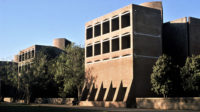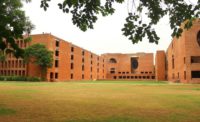The Rajpath, the central axis of New Delhi used to be one of the most beautiful urban spaces in the world. The view from India Gate at one end, to Sir Edwin Lutyens’s Rashtrapati Bhavan (formerly the Viceroy’s House under the British Raj built 1912-1931) at the other end, over two miles away, supplies a breath-taking spectacle. The axis culminates in the extraordinary dome of the Rashtrapati Bhavan, a synthesis of a western classical cupola and a Buddhist stupa which rises from Raisana Hill. Flanked on either side by the two Secretariats and the circular Parliament Building (designed by Sir Herbert Baker, 1912 to 1928), the ensemble is a masterpiece of Baroque processional planning. The buildings themselves fuse Indian and western motifs in red or amber colored sandstone, materials typical of past monuments in the region of Delhi over the centuries. This concentration of state buildings and institutions was intended to anchor British Imperial power for the long term.
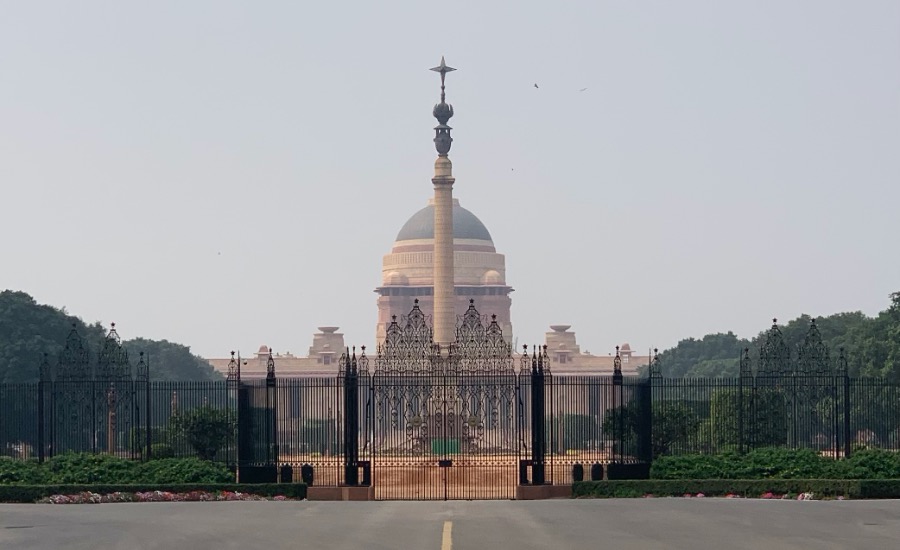
The dome of Rashtrapati Bhavan (Formerly known as the Viceroy’s House), Sir Edwin Lutyens, 1912-1931. Photo ©Thomas Kligerman, click to enlarge.
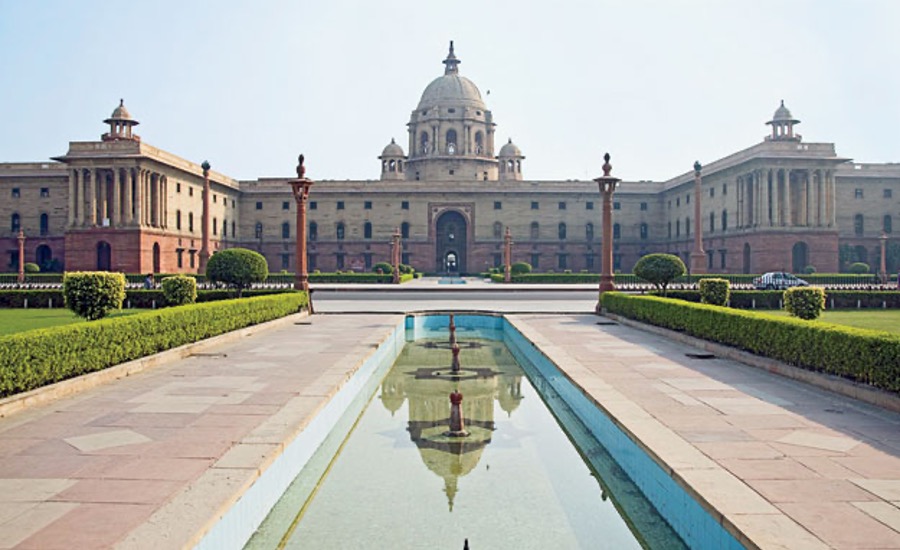
Secretariat, North block, Sir Herbert Baker, 1931. Photo ©Laurie Jones
With the Independence of India in 1947, the Viceroy’s House became that of the President of the new nation, and the great esplanade became an open-air democratic space for all citizens, both a public park and a setting for such rituals as the Republic Day parades every year on January 26th. In ensuing decades, new institutions were created along the fringes for government bureaucracies but also for cultural and archival purposes, such as the National Art Museum, the National Archives Building, and the Indira Gandhi National Center for the Arts. In effect, the Rajpath became an alleyway of cultural memories, preserving the priceless artistic and archival treasures of the nation and making them easily available to the public. Part of the beauty of the place resided in the ease of access from all sides, for all levels of society. I have vivid memories of an evening in the hot season 40 years ago, with ice cream vendors gathered around India Gate, children playing on the grass, and people from the stifling streets of Old Delhi coming to Rajpath to cool off and enjoy some fresh air, as the pale orange disk of the setting sun descended beyond the monuments on Raisana Hill in the distance.
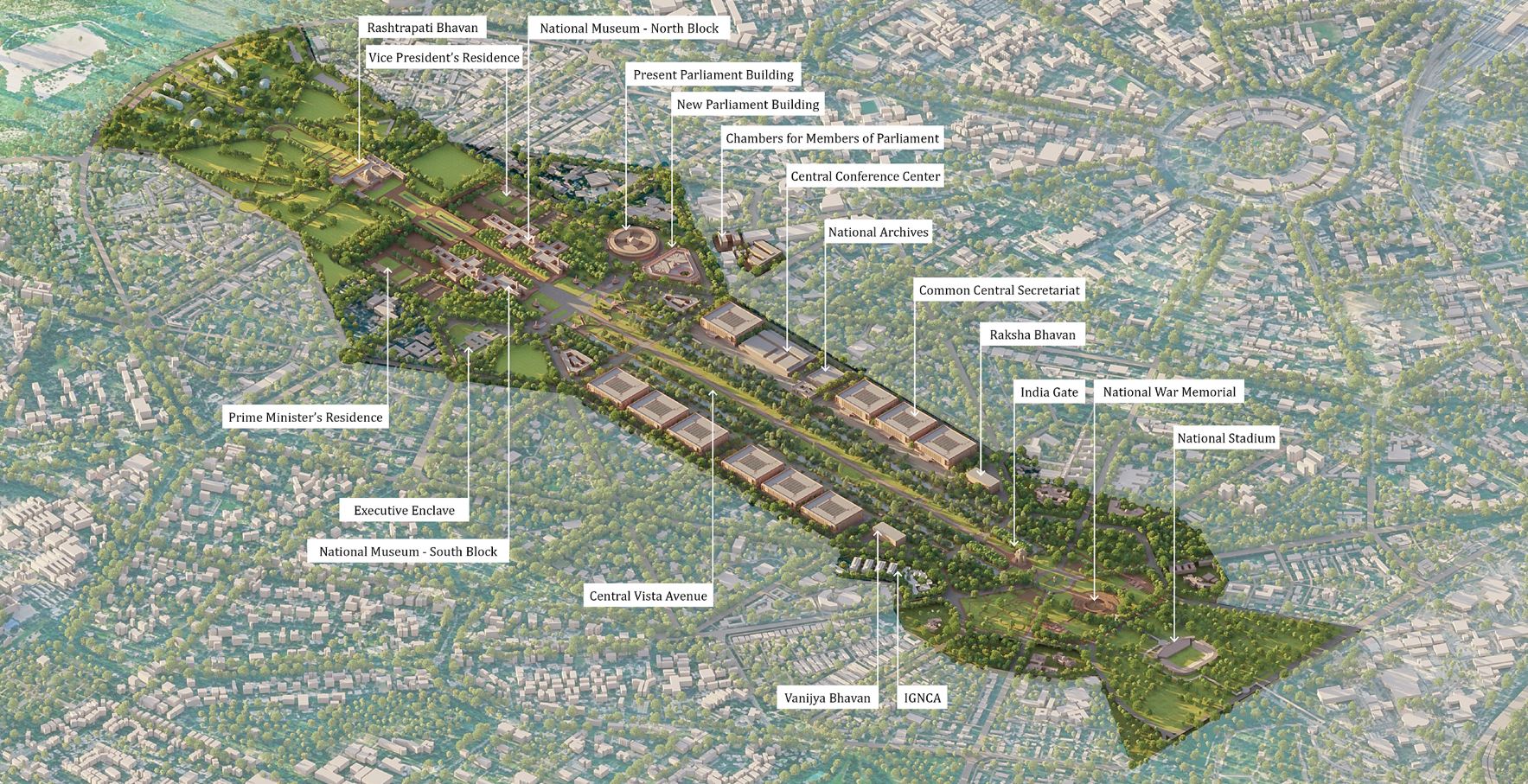
Click plan to enlarge
Site Plan, Central Vista project, designed by Bimal Patel / HCP. Image courtesy HCP
The Indian Government’s Central Vista project, designed by Bimal Patel and his firm HCP, is now being executed at top speed and at a pharaonic expense of approximately $3 billion, involves a massive and destructive rearrangement of this entire area, all in the name of Prime Minister Narendra Modi’s supposed aim of signaling a new, “post-colonial” vision for India and celebrating 75 years of Independence in 2022. The project includes the creation of a vast new Parliament Building alongside the old; an extravagant new Prime Minister’s residence; the destruction of a dozen institutional buildings along the Rajpath (representing almost 5 million square feet of space), and the construction of huge, monotonous office blocks of little aesthetic distinction on each side of the Rajpath, to provide room for over 50 ministries, containing 70,000 people bureaucrats and workers.
This assault on architectural heritage is accompanied by radical rearrangements of cultural and documentary contents. The artistic and archival holdings of the National Art Museum, National Archives Building and Indira Gandhi National Centre for the Arts, are being stored temporarily in a luxury hotel before being integrated somehow in the two existing Secretariat buildings, although there is no transparency about these plans. This transfer of national, in fact universal, treasures, some of them ancient works of art and fragile manuscripts, is risky in the extreme. Scholars, museum directors, and archivists from India and around the world have already raised the alarm. The documentation of national history and the preservation of treasures essential to the collective memory are without a clear future museological or ideological direction. The question has been posed: will history be rewritten, presented and represented to fit the agendas of the extreme Hindu nationalism of the present power base?
There is no doubt that some existing ministries and other public works along the edges of the Rajpath needed restoration and upgrading in terms of new technologies and interior layouts. But to demolish all of them completely seems excessive and wasteful in the extreme, especially at a moment of national economic crisis exacerbated by the coronavirus hitting India (critics in the national press assert that the budget for the Central Vista could create dozens of hospitals and vaccinate roughly three quarters of the population). None of these buildings, dating mostly from the 1950s and 1960s with their vague historical references is a “masterpiece” as are Lutyens’s outstanding works. But they are part of the architectural heritage of the evolving cityscape, and they record moments in post-Independence history, starting with Jawaharlal Nehru’s tenure in 1947. Surely they could be updated to do their job without the expense and ecological impact of destruction followed by new construction? Some of them—the cultural buildings and museums in particular—should be preserved with their contents intact.
What Patel is erecting instead is a solid phalanx of grim, identical, and repetitive rectangular office blocks, each 490 feet long, 443 feet on the sides, and 130 feet tall, with vast interior courtyards. Each unit will contain enough offices for 6,000 workers. These blocks, ten in all, will march relentlessly down each side of the Rajpath in a manner that encroaches on existing public space and establishes barriers between the Rajpath and the neighboring areas, like a controlling wall. With their bland exterior façades and their fully glazed atria, these behemoths could have been yanked directly from an office park on a highway somewhere in the U.S. in the 1970s. This is an odd way of signaling a “new Indian Identity” for the 75-year-old democracy. The overall effect of this symmetrical and regimented array of banal boxes is curiously dictatorial.
The Central Vista project implies an extreme bureaucratic centralization precisely at a moment when modern communications systems permit work at a distance. Roughly 16,000 cars will be coming into work and leaving everyday, in a city that already suffers from nightmarish traffic jams and one of the worst levels of pollution in the world (despite “official” aerial views suggesting a luminous and limpid green arcadia). There is a metro system and there will be underground tunnels with fast links between ministries; nonetheless, there is already discussion of plowing wider traffic arteries, even double-level roads, through the verdant carpet of low-rise New Delhi, with further negative impact on quality of life, air, buildings, and vegetation. The Central Vista project is a retrograde and anti-ecological urban plan which, in social terms, is liable to turn an entire stretch of the Rajpath, once so free and easy, into a surveyed security zone.
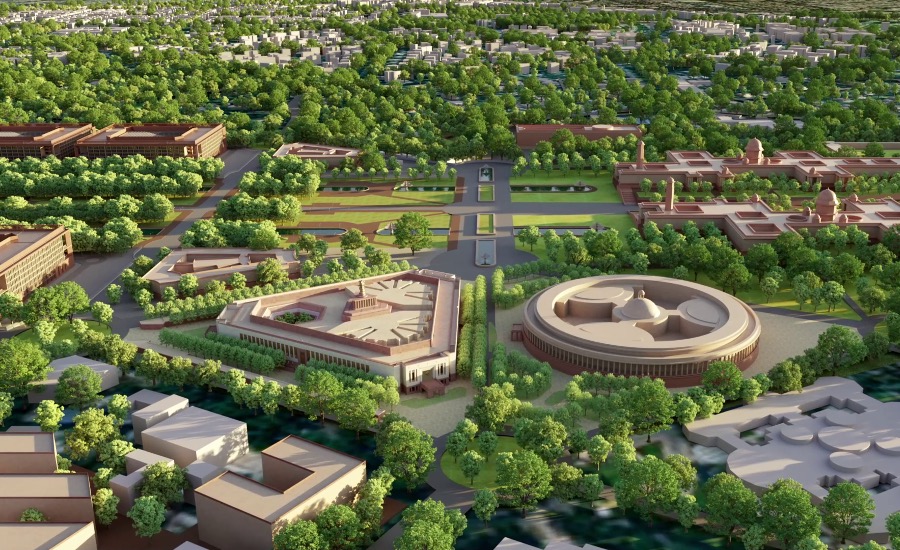
Model, New Parliamentary House, by Bimal Patel/HCP, next to existing Parliamentary House by Herbert Baker, 1912-13. Image courtesy HCP
The proposed new Parliament building designed by Patel will sit on a triangular site next to the existing one The earlier circular building was conceived by Herbert Baker in 1912-13 to house the Imperial Legislative Council and opened in 1927. In 1950, with the foundation of the Indian Constitution, its three main chambers were adapted for parliamentary use. The cylindrical structure, circled by 144 columns, was inspired in its overall form by the 11th century Chausath Yogini temple in Madhya Pradesh. Over the years, the Parliament building has proved increasingly inefficient and subject to several clumsy alterations and additions. One way of dealing with these shortcomings would have been to restore and update the existing structure and then add a sympathetic extension, as happened with the exemplary Parliamentary Library behind the old Parliament House, designed by Raj Rewal, 1992-2002. This fuses modernity and tradition in its forms, spaces, structure, and materials, and rests on a centralized plan inspired by the 15th century Jain Temple at Ranakpur. It responds to the Parliament at an abstract level without mimicking it or competing with it, and fits perfectly the urban context.
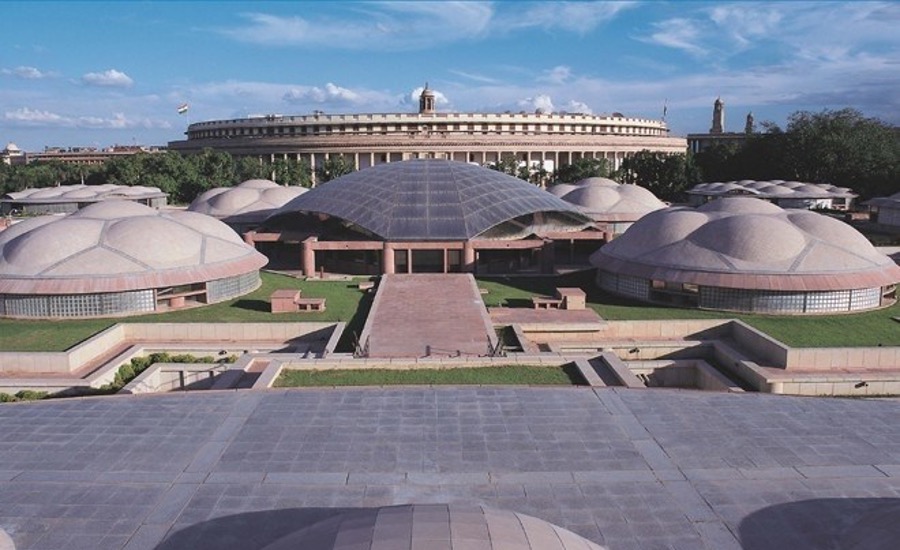
Parliamentary Library, designed by Raj Rewal Associates, 1992-2002, with Herbert Baker’s Parliamentary House in the background. Photo courtesy Wikimedia Commons/Raj Rewal Associates
By contrast, Patel’s Parliament House proposes itself as the protagonist. It dominates its predecessor and is intended to be a monument marking the political program of the “new era”: a major statement of some kind embodying a fresh vision for Indian democracy. Yet in many respects it is an overblown and feeble copy of Baker’s old parliament from a century ago. It imitates directly but without sufficient abstraction or transformation. The two main chambers echo the form and disposition of those in the old building but have been expanded to allow for 888, instead of 552 seats, in the case of the Lower House (the Lok Sabha), and 384, instead of 245, seats, in the Upper House (Rajiya Sabha). Up- to-the minute technology will assure improved functioning and the members will gain a lot of space for all their activities.
Nevertheless, the new Parliament House is disappointing on the aesthetic and symbolic levels. The interiors resemble those of a pretentious hotel while the exterior façades provide skin-deep imitations of Baker’s elegant plinth and colonnade. Patel’s version is a postmodern pastiche without authenticity or expressive depth. It would have been fashionable for a brief period 35 years ago but is already outmoded. Besides, monuments should not be bound by fashion and should transcend time. That is certainly not the case here. Nor is there any evidence of the craftsmanship manifest in Baker’s design. The details are stilted and schematic. The overall form is ponderous and has inevitably been compared to a wedding cake, even to a Soviet era monument clad in stilted classical clichés. The new building is crowned by a sort of spire formed from a column with four lions, a reference to the columns of Ashoka (c. 280 BC) in the Mauryan Empire. But even this topknot looks as if it has been stuck on.
Prime Minister Nehru had Le Corbusier’s Capitol Complex at Chandigarh, constructed in the 1950s, to mark the aspirations of the new, secular democracy of India. The Government of Pakistan (and later of Bangladesh) had the magisterial National Assembly in Dhaka designed by Louis Kahn in 1962, completed in 1983, represent the state. These are impossible acts to follow as they are universal modern masterpieces, timeless but of their time. Prime Minister Modi has Bimal Patel as his state architect, an organizer of infrastructure on a large scale, but hardly a designer of major architectural interest. The Central Vista proposed is already a historical, architectural, and urbanistic relic out of touch with the real needs and aspirations of the times. It is lacking in any positive social or political meaning for the amelioration of daily life. It is destroying the architectural and cultural heritage of a great national capital. It is shredding the collective memory of the Indian Republic at a crucial moment in its history.
The aim was to provide a vision of the radiant future for India, but the architectural results are fatigued and the urban proposals regressive. One can only hope that the trees will grow up to mask the political and aesthetic embarrassment of the new Parliament. The supreme irony in all of this talk of a ‘post-colonial era’ is that the monuments designed by the architects of the British Raj —by Lutyens and Baker —for New Delhi manifest a more developed sense of Indian tradition than almost anything produced along the Rajpath since, Rewal’s fine Parliamentary Library being the notable exception. What results with the Central Vista is a sort of symbolic devaluation of modern architecture on the one hand, and of tradition on the other. Perhaps this is a true mirror of the ideological contradictions at work in contemporary globalized and nationalist India. In spite of its drawbacks, the effort is still moving forward: according to reports, the work on the Central Vista and the New Parliament has begun.


